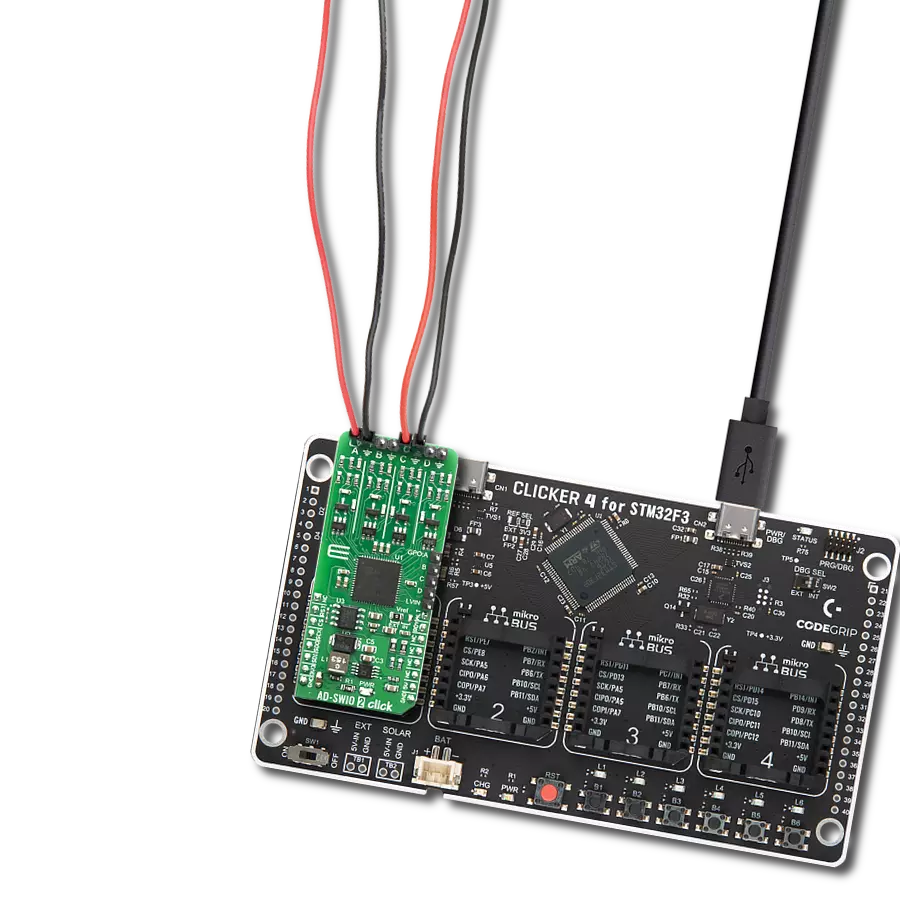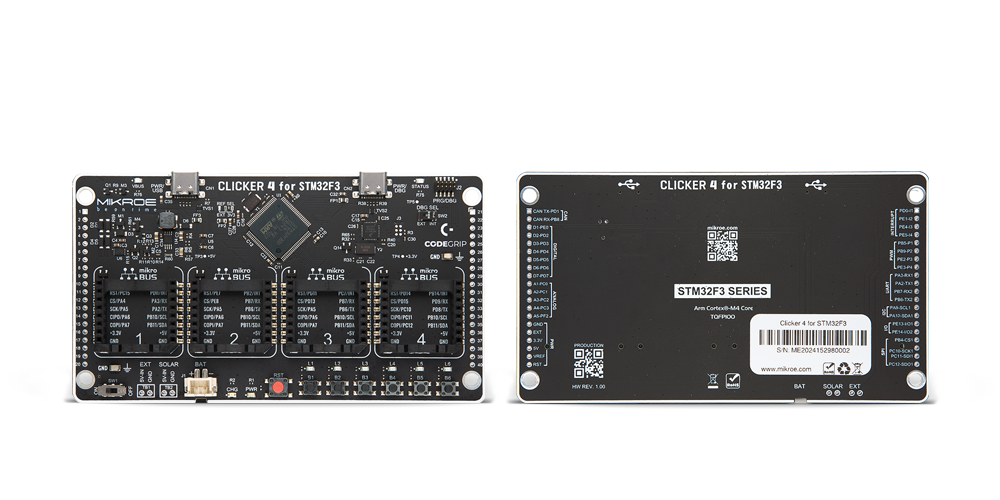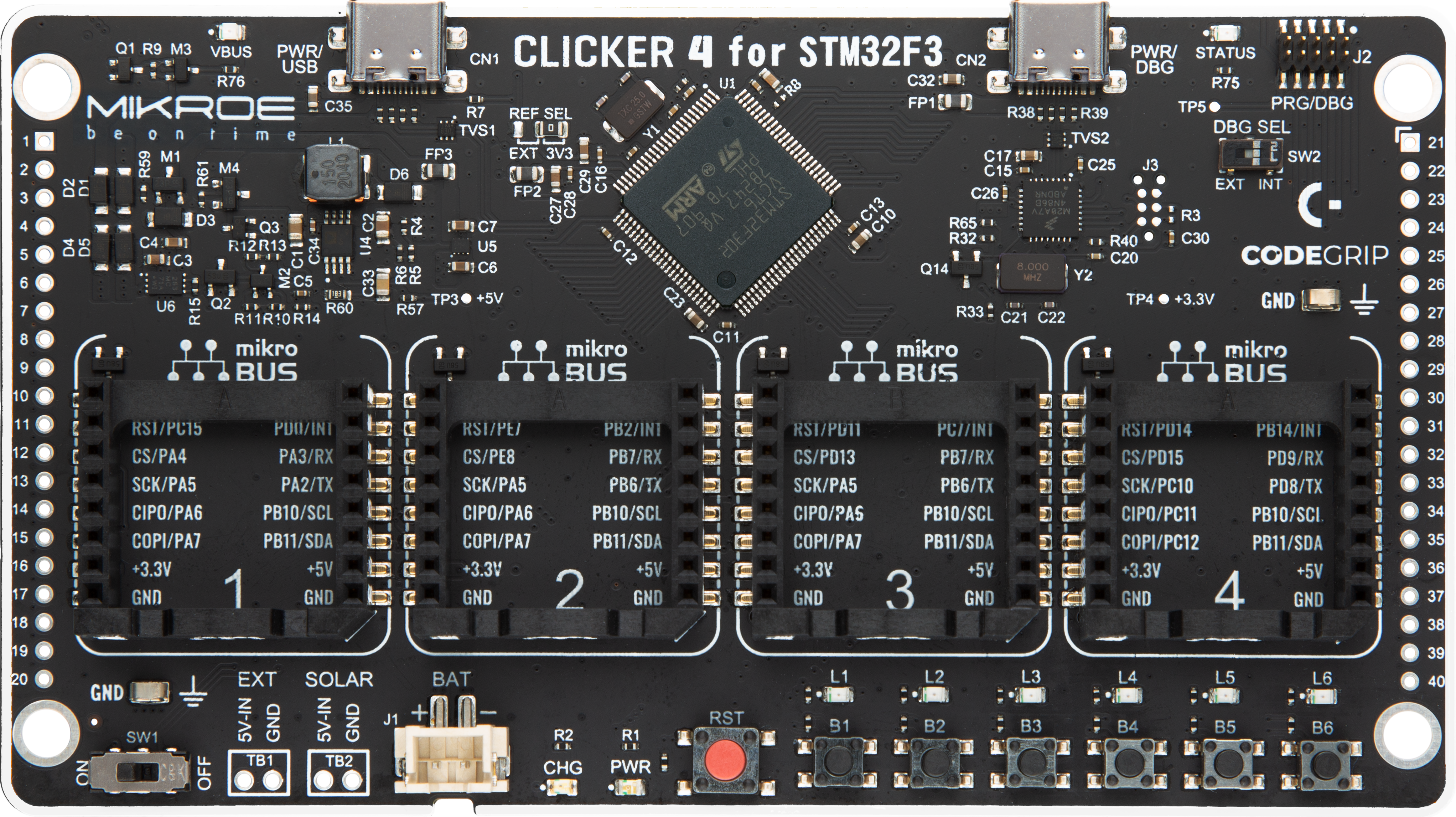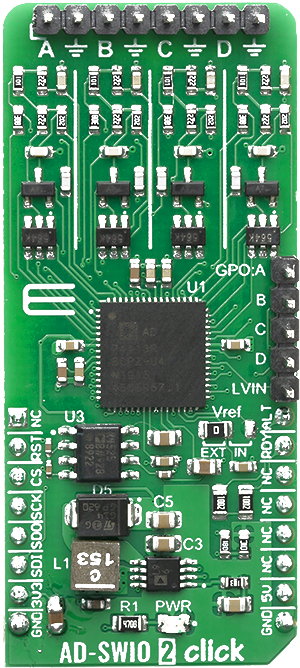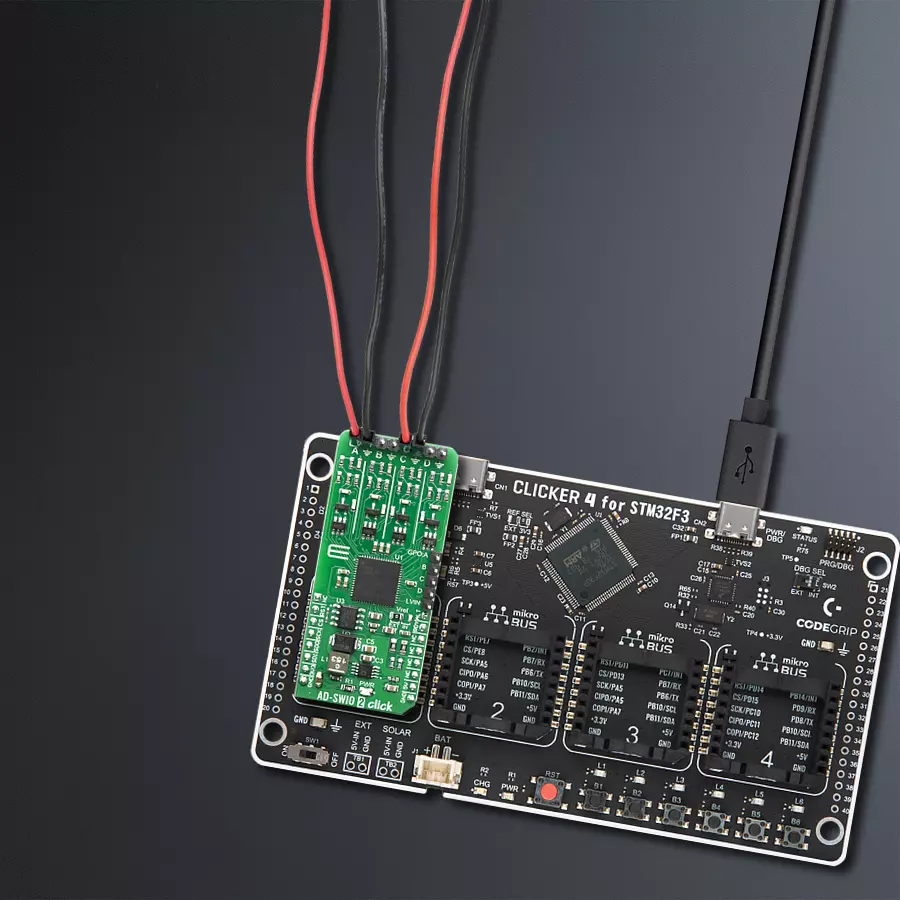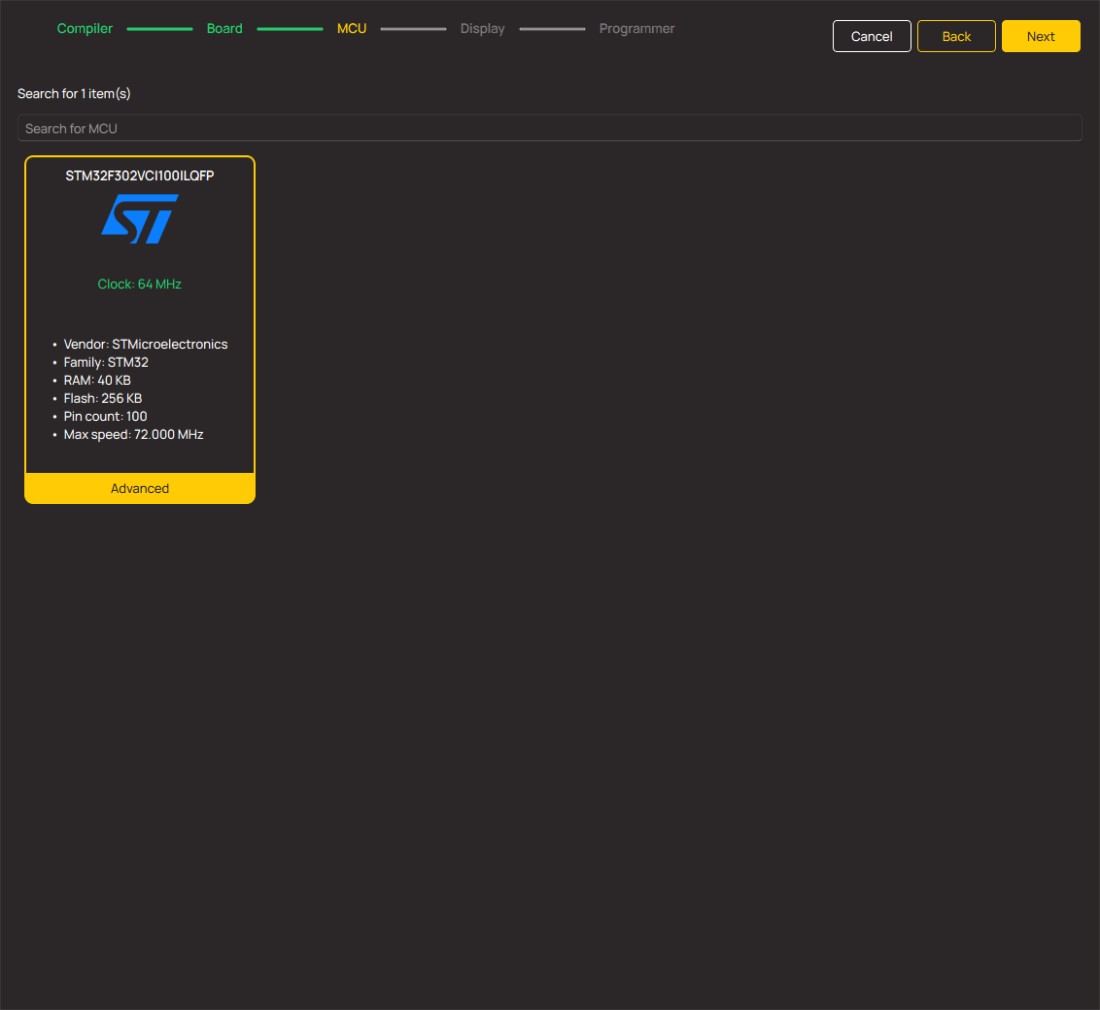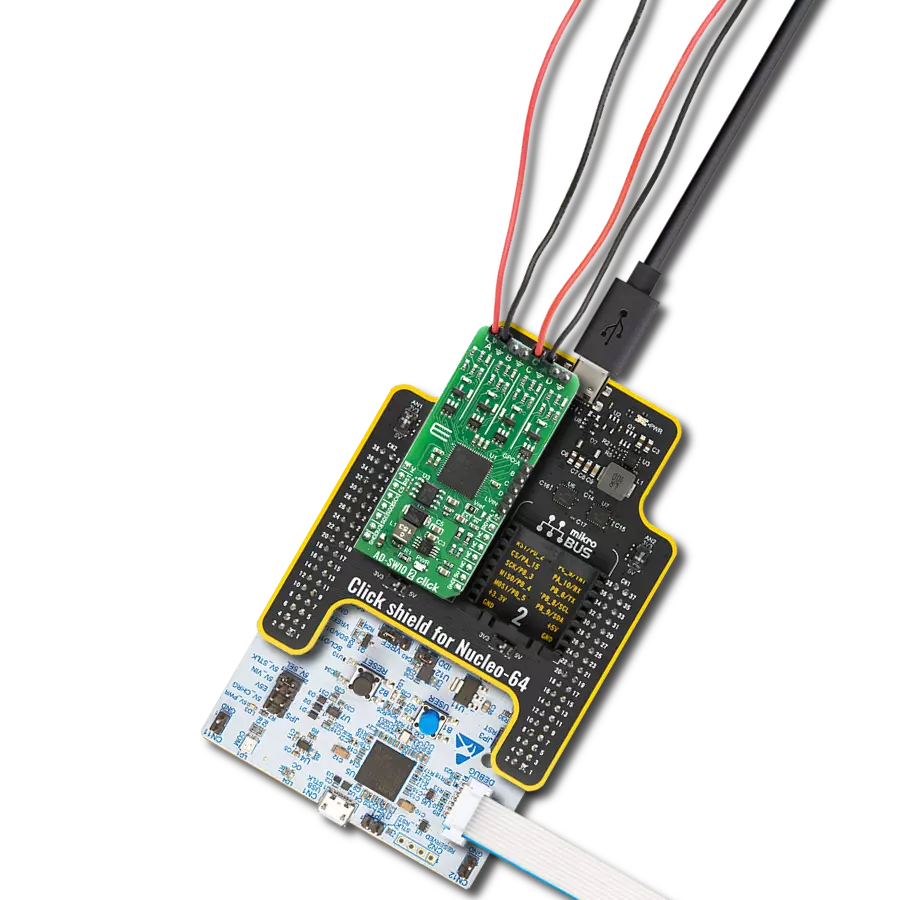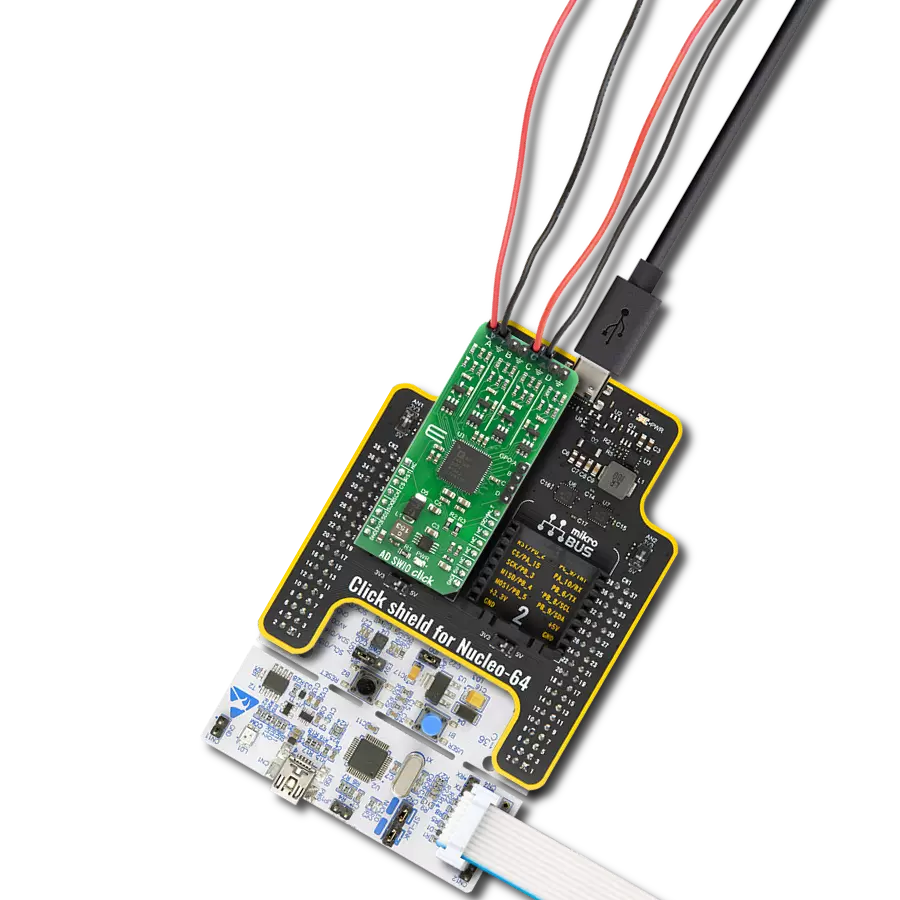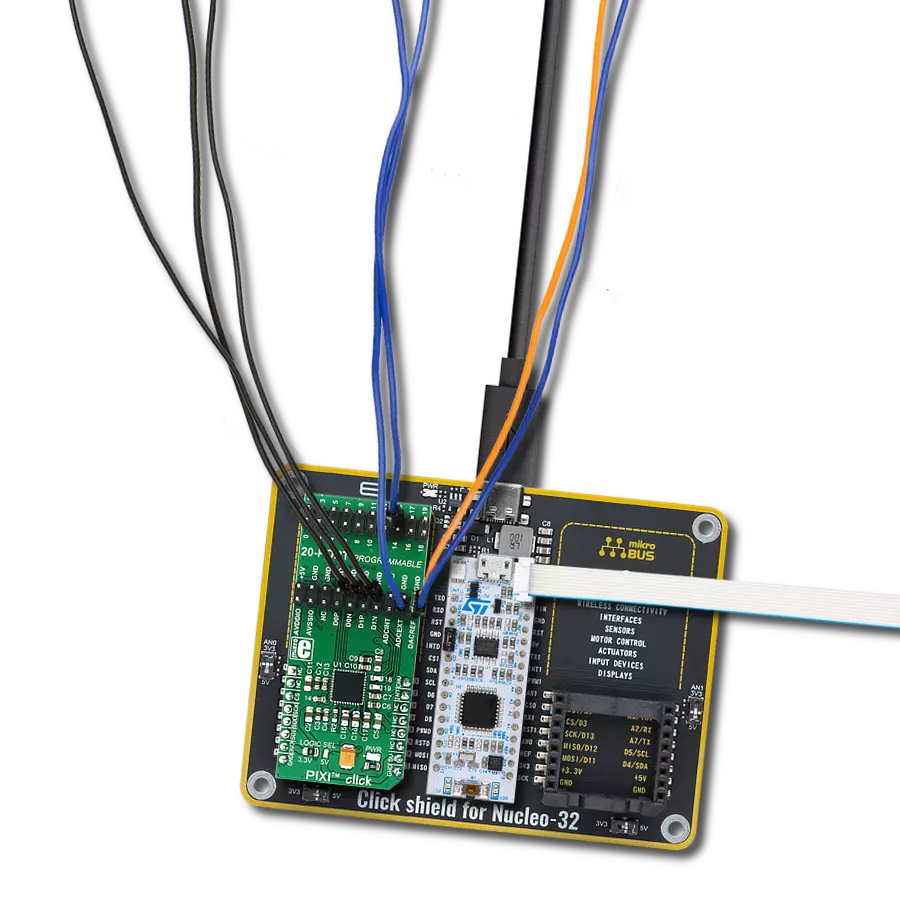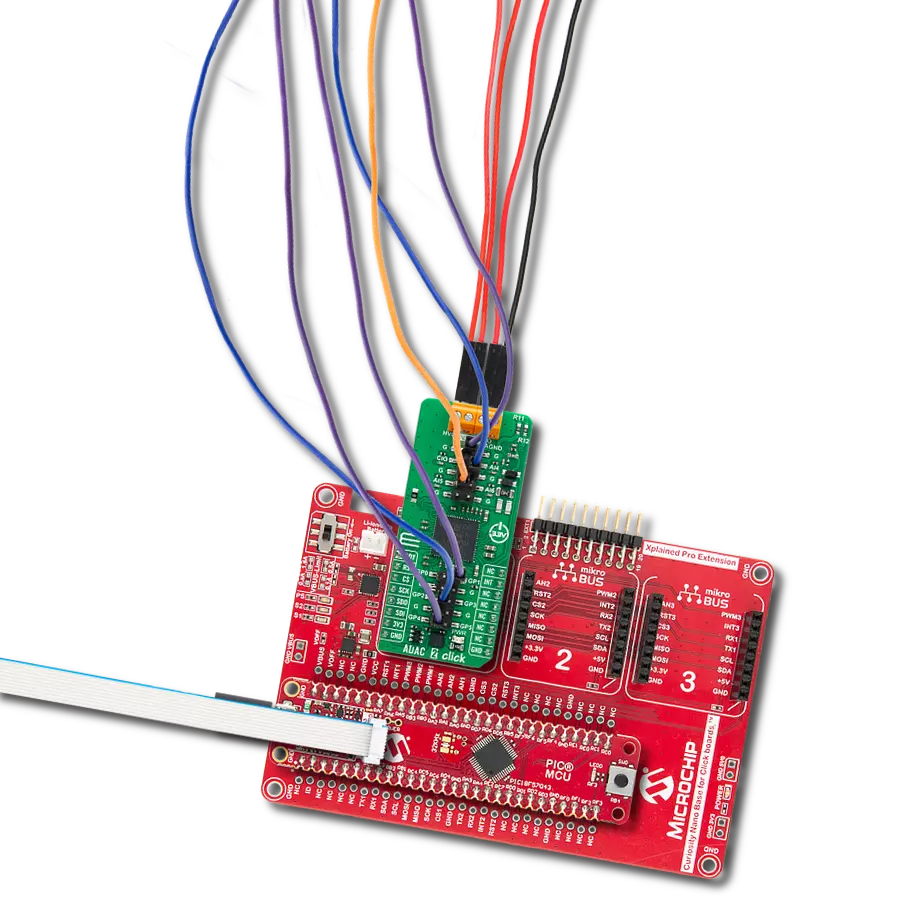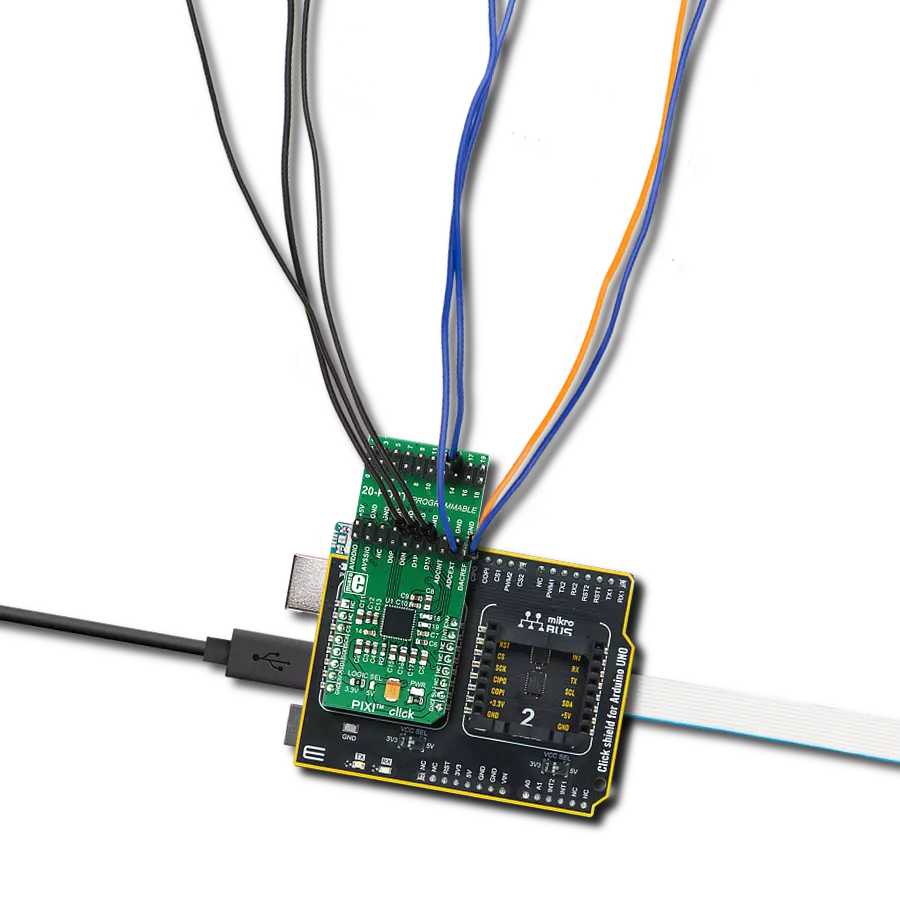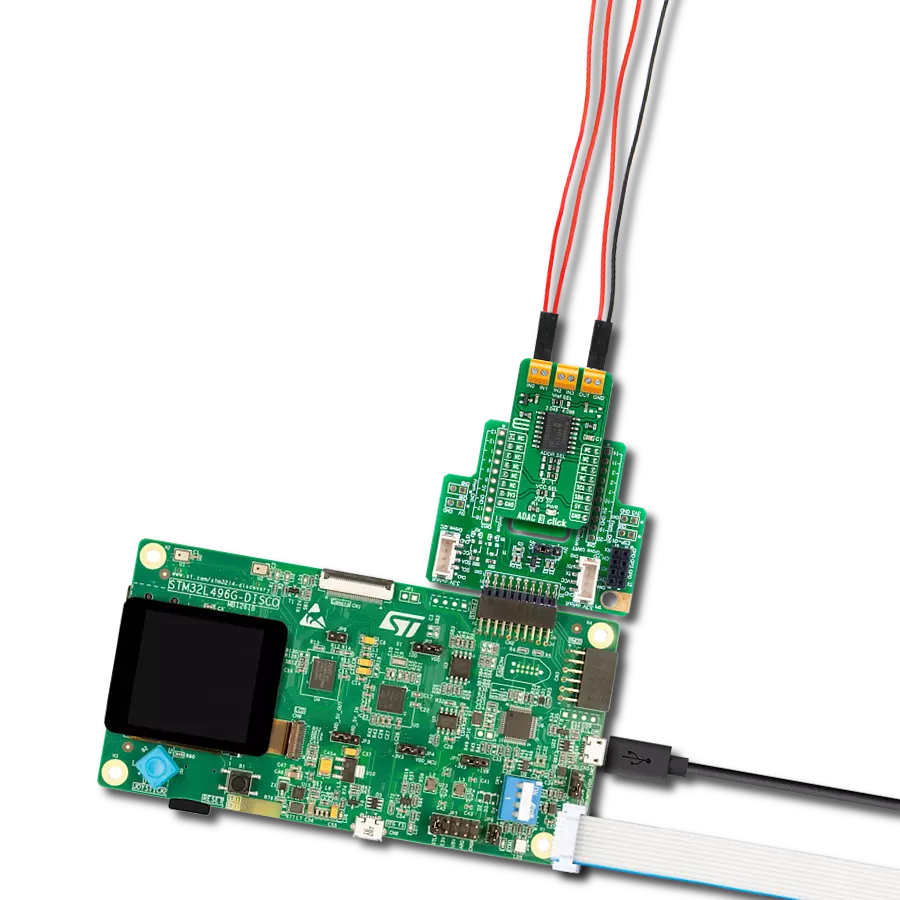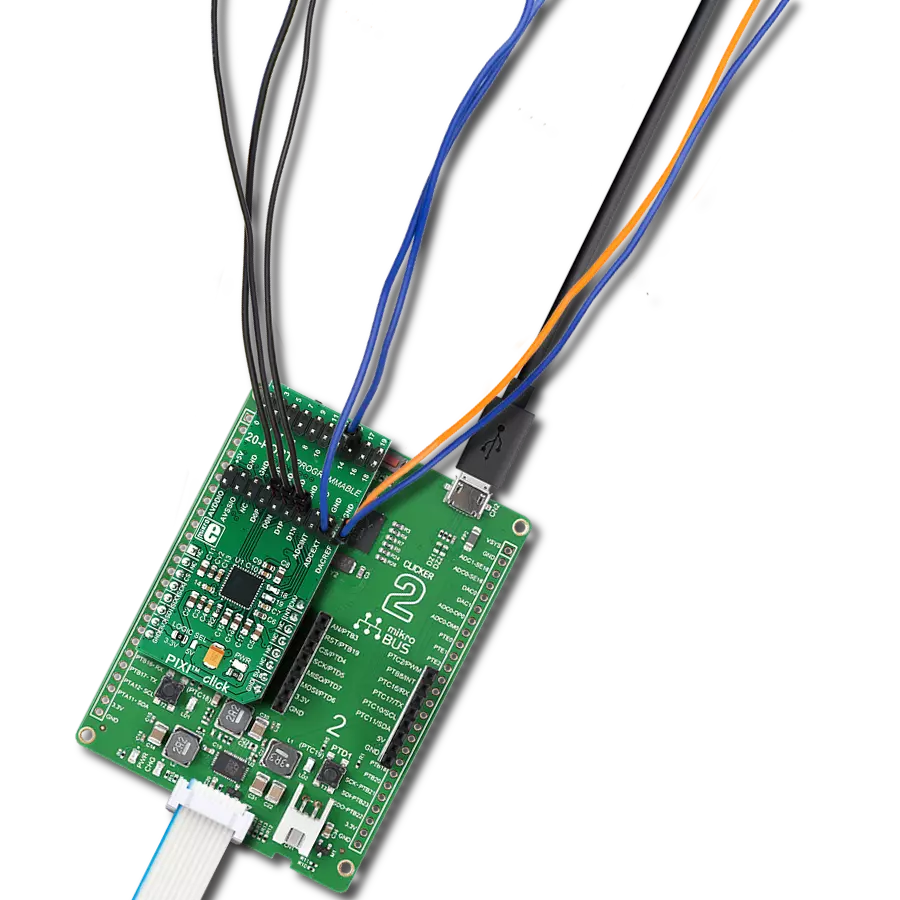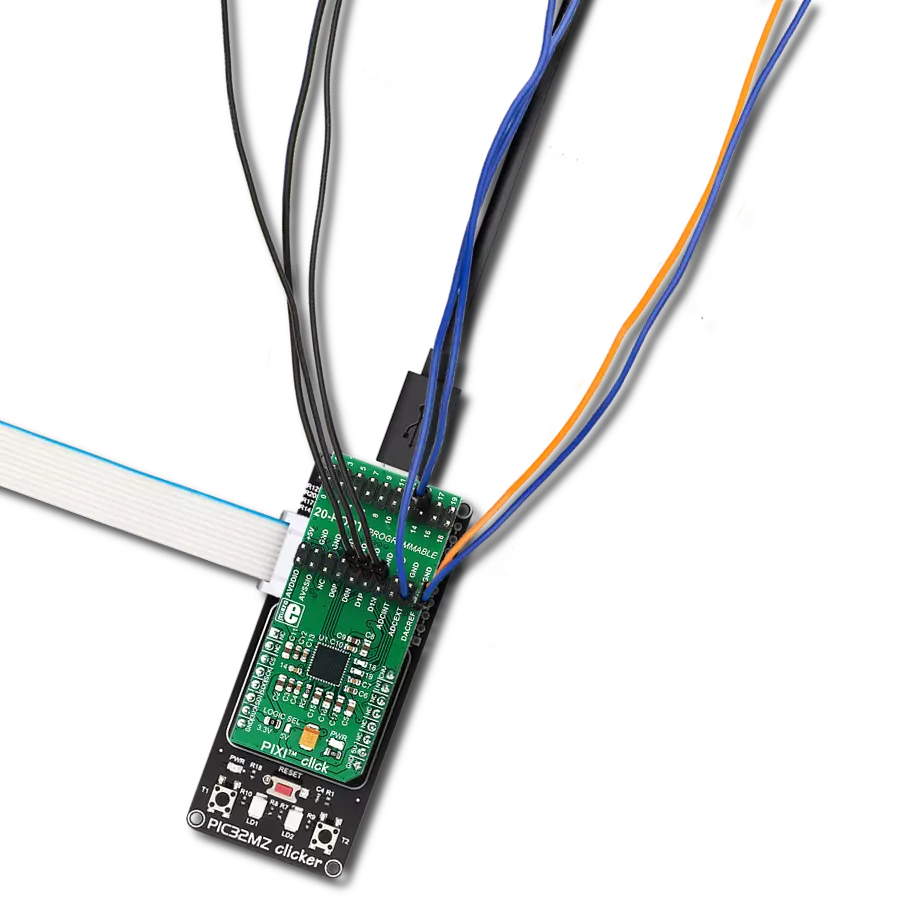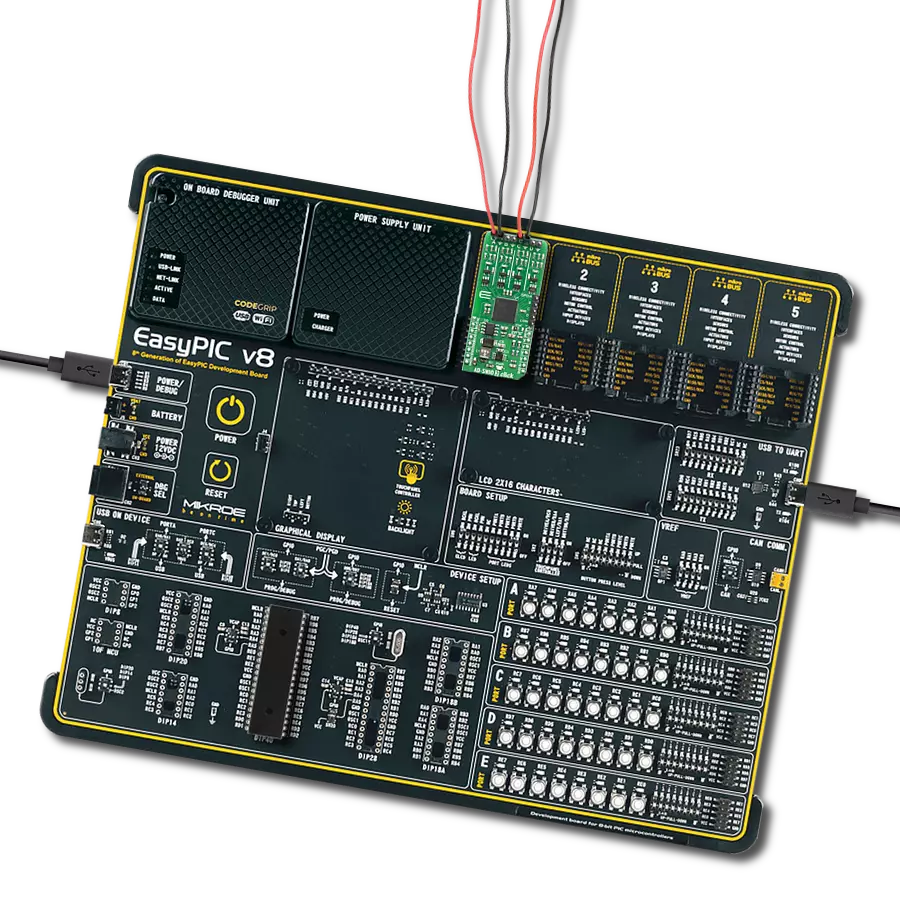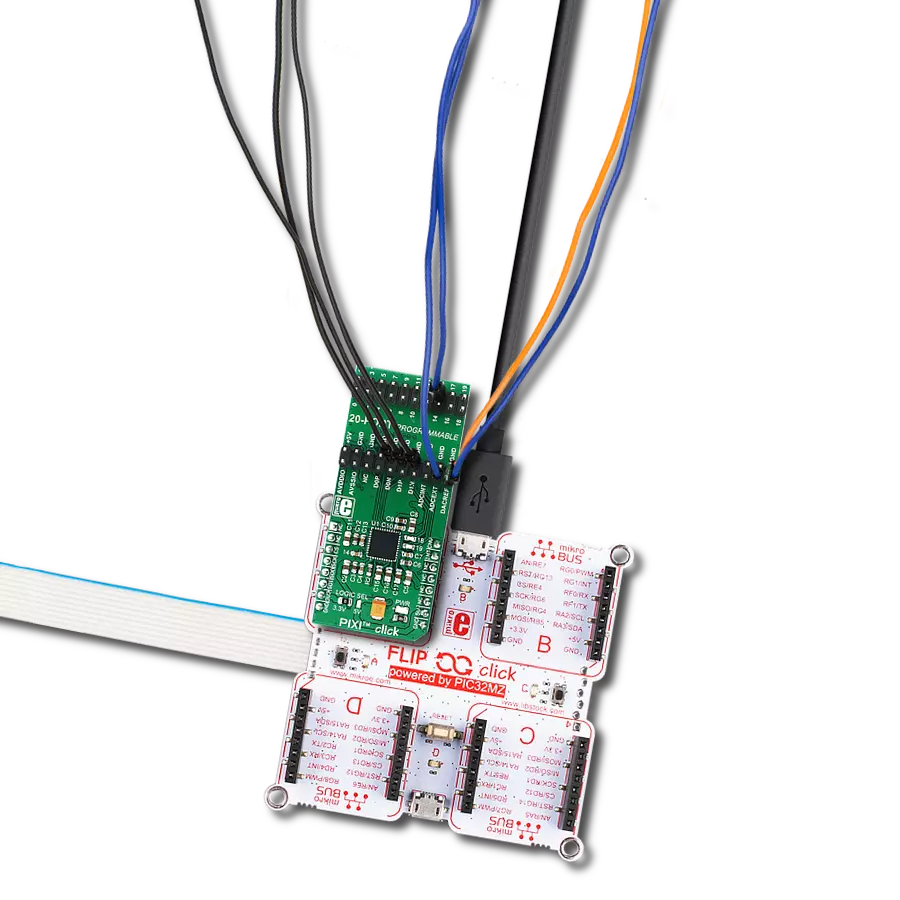Elevate your design's abilities with the ultimate ADC-DAC combo solution
A
A
Hardware Overview
How does it work?
AD-SWIO 2 Click is based on AD74413R, a 16-bit analog-to-digital converter (ADC), and a 13-bit digital-to-analog converter (DAC) from Analog Devices. There are several modes related to the AD74413R. These modes are voltage output, current output, voltage input, externally powered current input, loop-powered current input, external RTD measurement, digital input logic, and loop-powered digital input. The ADC can measure either the voltage across the 100Ω RSENSE or the voltage at each channel's I/OP_x screw terminal. In high impedance mode, the ADC, by default, measures the voltage across the screw terminals (I/OP_x to I/ON_x) in a 0 V to 10 V range. The ADC also provides diagnostic information on user-selectable inputs such as supplies, internal die temperature, reference, and regulators. The AD74413R can operate with either an external or an internal reference. The reference input requires 2.5 V for the AD74413R to function correctly. The reference voltage is internally buffered before being applied to the DAC and the ADC. The AD-SWIO 2 Click contains a jumper for the selection reference voltage; the left position (Default) is the selection
of external reference voltage. The ADR4525 from Analog Devices provides an external reference voltage. The ADR4525BRZ is high precision, low noise voltage reference featuring ±0.02% maximum initial error. By switching to the right position of the Vref jumper, the AD74413R uses the internal reference voltage. If The AD-SWIO 2 Click using internal reference voltage, the REFIN pin must be tied to the REFOUT pin. The AD-SWIO 2 Click has four GPO-x pins, one per channel (GPO-A, GPO-B, GPO-C, GPO-D). Each channel GPO-x pin can be configured to the logic outputs of the digital input functions or a logic high or low output. The GPO-x pins can be set via the GPO_SELECT bits within the GPO_CONFIGx registers. The Click board™ also contains an LVIN ( Low Voltage Input) pin, the measurement voltage range on this pin is 0V to 2.5V. The AD74413R contains four 13-bit DACs, one per channel. Each DAC core is a 13-bit string DAC. The architecture structure consists of a string of resistors, each with a value of R. The digital input code loaded to the DAC_CODEx registers determines which string node the voltage is tapped off from and fed into the
output amplifier.This architecture is inherently monotonic and linear. The AD74413R has short-circuited limit in voltage output mode that is programmable per channel. The circuit minimizes glitching on the I/OP_x screw terminal when the AVDD supply is ramping, or the use case configuration is changed. This short-circuit limit you can regulate with a positive analog supply on the AVDD pin, Output voltage on AD-SWIO 2 Click is limited to +20V. The AD-SWIO 2 Click is equipped with the ADP1613 step-up dc-to-dc switching converter from Analog Devices with an integrated power switch capable of providing an output voltage as high as 20V. This Click board™ can only be operated with a 3.3V logic voltage level. The board must perform appropriate logic voltage level conversion before using MCUs with different logic levels. However, the Click board™ comes equipped with a library containing functions and an example code that can be used as a reference for further development.
Features overview
Development board
Clicker 4 for STM32F3 is a compact development board designed as a complete solution, you can use it to quickly build your own gadgets with unique functionalities. Featuring a STM32F302VCT6, four mikroBUS™ sockets for Click boards™ connectivity, power managment, and more, it represents a perfect solution for the rapid development of many different types of applications. At its core, there is a STM32F302VCT6 MCU, a powerful microcontroller by STMicroelectronics, based on the high-
performance Arm® Cortex®-M4 32-bit processor core operating at up to 168 MHz frequency. It provides sufficient processing power for the most demanding tasks, allowing Clicker 4 to adapt to any specific application requirements. Besides two 1x20 pin headers, four improved mikroBUS™ sockets represent the most distinctive connectivity feature, allowing access to a huge base of Click boards™, growing on a daily basis. Each section of Clicker 4 is clearly marked, offering an intuitive and clean interface. This makes working with the development
board much simpler and thus, faster. The usability of Clicker 4 doesn’t end with its ability to accelerate the prototyping and application development stages: it is designed as a complete solution which can be implemented directly into any project, with no additional hardware modifications required. Four mounting holes [4.2mm/0.165”] at all four corners allow simple installation by using mounting screws. For most applications, a nice stylish casing is all that is needed to turn the Clicker 4 development board into a fully functional, custom design.
Microcontroller Overview
MCU Card / MCU
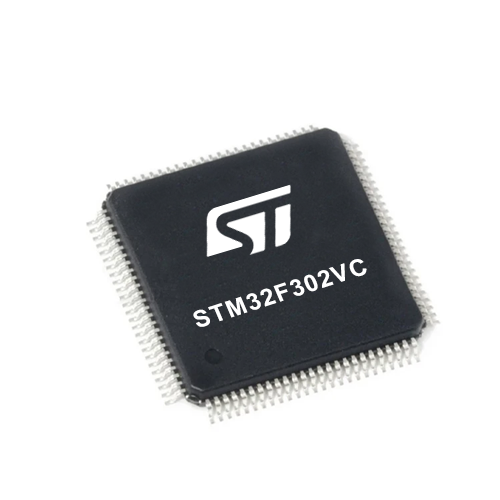
Architecture
ARM Cortex-M4
MCU Memory (KB)
256
Silicon Vendor
STMicroelectronics
Pin count
100
RAM (Bytes)
40960
Used MCU Pins
mikroBUS™ mapper
Take a closer look
Click board™ Schematic

Step by step
Project assembly
Track your results in real time
Application Output
1. Application Output - In Debug mode, the 'Application Output' window enables real-time data monitoring, offering direct insight into execution results. Ensure proper data display by configuring the environment correctly using the provided tutorial.

2. UART Terminal - Use the UART Terminal to monitor data transmission via a USB to UART converter, allowing direct communication between the Click board™ and your development system. Configure the baud rate and other serial settings according to your project's requirements to ensure proper functionality. For step-by-step setup instructions, refer to the provided tutorial.

3. Plot Output - The Plot feature offers a powerful way to visualize real-time sensor data, enabling trend analysis, debugging, and comparison of multiple data points. To set it up correctly, follow the provided tutorial, which includes a step-by-step example of using the Plot feature to display Click board™ readings. To use the Plot feature in your code, use the function: plot(*insert_graph_name*, variable_name);. This is a general format, and it is up to the user to replace 'insert_graph_name' with the actual graph name and 'variable_name' with the parameter to be displayed.

Software Support
Library Description
This library contains API for AD-SWIO 2Click driver.
Key functions:
adswio2_get_conv_results- This function allows user to get the converted results of the selected channel.adswio2_status_pin_ready- This function checks the status of the ready pin.
Open Source
Code example
The complete application code and a ready-to-use project are available through the NECTO Studio Package Manager for direct installation in the NECTO Studio. The application code can also be found on the MIKROE GitHub account.
/*!
* \file
* \brief AdSwio2 Click example
*
* # Description
* This Click is a quad-channel software configurable input/output solution for building
* and process control application. The AD-SWIO 2 Click contains four 13-bit DACs, one
* per chanal, and 16-bit Σ-∆ ADC. These options give a lot of flexibility in choosing
* functionality for analog output, analog input, digital input, resistance temperature
* detector (RTD), and thermocouple measurements integrated into a single chip solution
* with a serial peripheral interface (SPI).
*
* The demo application is composed of two sections :
*
* ## Application Init
* Performs a hardware reset of the Click board and
* executes a default configuration that enables channel A and sets it to measure voltage
* input in the range from 0V to 10V, with 4800 SPS.
*
* ## Application Task
* Waits for the data ready and then reads the results of ADC conversion from channel A
* and if response is ok, then prints the results on the uart console.
*
* ## Additional Functions
*
* - void application_default_handler ( uint8_t *err_msg ) - Sends an error report messages from Click
* driver to initialized console module. It must be set using adswio2_set_handler function.
*
* \author MikroE Team
*
*/
// ------------------------------------------------------------------- INCLUDES
#include "board.h"
#include "log.h"
#include "adswio2.h"
// ------------------------------------------------------------------ VARIABLES
static adswio2_t adswio2;
static log_t logger;
static uint8_t adswio2_rdy;
static adswio2_err_t adswio2_err;
static uint16_t adswio2_ch_a;
static uint16_t timeout;
static float adswio2_res;
const uint16_t ADSWIO2_RANGE_VOLT_MV = 10000;
const uint32_t ADSWIO2_RANGE_RESOLUTION = 65536;
// ------------------------------------------------------- ADDITIONAL FUNCTIONS
void application_default_handler ( uint8_t *err_msg )
{
char *err_ptr = err_msg;
log_printf( &logger, "\r\n" );
log_printf( &logger, "[ERROR] : %s", err_ptr );
log_printf( &logger, "\r\n" );
}
// ------------------------------------------------------ APPLICATION FUNCTIONS
void application_init ( void )
{
log_cfg_t log_cfg;
adswio2_cfg_t cfg;
/**
* Logger initialization.
* Default baud rate: 115200
* Default log level: LOG_LEVEL_DEBUG
* @note If USB_UART_RX and USB_UART_TX
* are defined as HAL_PIN_NC, you will
* need to define them manually for log to work.
* See @b LOG_MAP_USB_UART macro definition for detailed explanation.
*/
LOG_MAP_USB_UART( log_cfg );
log_init( &logger, &log_cfg );
log_info( &logger, "---- Application Init ----" );
// Click initialization.
adswio2_cfg_setup( &cfg );
ADSWIO2_MAP_MIKROBUS( cfg, MIKROBUS_1 );
adswio2_init( &adswio2, &cfg );
Delay_ms ( 100 );
adswio2_default_cfg( &adswio2 );
Delay_ms ( 1000 );
adswio2_rdy = DUMMY;
adswio2_ch_a = DUMMY;
adswio2_res = DUMMY;
adswio2_err = ADSWIO2_ERR_STATUS_OK;
log_printf( &logger, " AD-SWIO 2 Click initialization done \r\n");
log_printf( &logger, "************************************\r\n");
}
void application_task ( void )
{
timeout = 0;
do
{
Delay_1ms( );
timeout++;
adswio2_rdy = adswio2_status_pin_ready( &adswio2 );
if ( timeout > 3000 )
{
timeout = 0;
log_printf( &logger, " Reinitializing...");
adswio2_default_cfg( &adswio2 );
log_printf( &logger, "Done\r\n");
}
}
while ( adswio2_rdy != 0 );
adswio2_err = adswio2_get_conv_results( &adswio2, ADSWIO2_SETUP_CONV_EN_CHA, &adswio2_ch_a );
if ( adswio2_err == ADSWIO2_ERR_STATUS_OK )
{
adswio2_res = adswio2_ch_a;
adswio2_res /= ADSWIO2_RANGE_RESOLUTION;
adswio2_res *= ADSWIO2_RANGE_VOLT_MV;
adswio2_ch_a = adswio2_res;
log_printf( &logger, " Voltage from channel A: %d mV\r\n", adswio2_ch_a );
log_printf( &logger, "-----------------------------------\r\n\r\n" );
Delay_ms ( 200 );
}
}
int main ( void )
{
/* Do not remove this line or clock might not be set correctly. */
#ifdef PREINIT_SUPPORTED
preinit();
#endif
application_init( );
for ( ; ; )
{
application_task( );
}
return 0;
}
// ------------------------------------------------------------------------ END
Additional Support
Resources
Category:ADC-DAC
